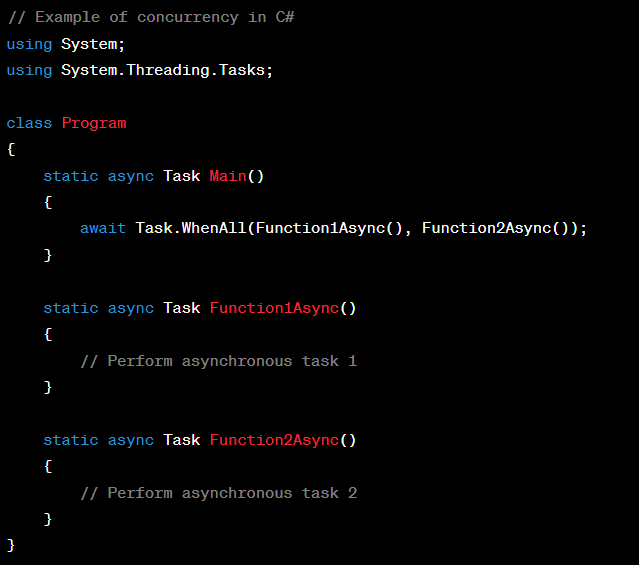Demystifying Concurrency vs. Parallelism: A Guide for Students and Programmers(Part - II)
Multithreading vs. Concurrency in C#
If you haven't read the first part, I would encourage you to read : Concurrency vs Parallelism
Within the realm of C# programming, terms like "multithreading" and "concurrency" are sometimes used interchangeably. However, they possess distinct connotations:
Multithreading
Multithreading involves the utilization of multiple threads within a single process. Threads represent small program units capable of running concurrently. In C#, multithreading enables concurrent task execution, such as handling user interface updates while processing data in the background.
Consider the following C# example:
Concurrency in C#
Concurrency in C# is frequently achieved through mechanisms
like async and await. These keywords enable developers to craft asynchronous
code proficient in efficiently managing multiple tasks and optimizing resource
utilization. Here's an example of concurrency in C#:
This code demonstrates how async and await can be employed to generate asynchronous tasks capable of concurrent execution.
Use Cases
With a firm grasp of concurrency and parallelism, let's examine their practical applications:
Use Case 1: Web Servers
Concurrency: Concurrency proves valuable for web servers
fielding multiple client requests. It ensures that the server can serve
multiple clients concurrently without obstructing any of them.
Parallelism: Parallelism can be employed to optimize
server-side processing tasks, such as image compression or database queries.
Multiple tasks can be executed in parallel to heighten performance.
Use Case 2: Data Processing
Concurrency: Concurrency shines when confronted with tasks
involving waits for external resources, such as file reads/writes or network
requests.
Parallelism: Parallelism excels when undertaking
computation-intensive tasks like data analysis. Tasks can be divided into
parallel subtasks, significantly curtailing processing time.
Benefits and Challenges
Before concluding, let's conduct a deep dive into the benefits and challenges of both concurrency and parallelism:
Benefits of Concurrency
1. Efficient Resource Utilization
Concurrency optimizes resource utilization, ensuring that the CPU remains active even during resource waits. A web server handling simultaneous client requests can efficiently allocate resources, preventing any idleness during database queries or file reads.
2. Suitable for I/O-Bound Tasks
Explanation: Concurrency excels in tasks awaiting external
resources, preventing unnecessary delays.
Example: In a video streaming application, concurrency
allows the concurrent fetching of video data while ensuring the user interface
remains responsive.
3. Easier to Implement and Debug
Explanation: Concurrent code is often simpler to write and
debug, thanks to its cooperative nature.
Example: Crafting asynchronous code using async and await in
JavaScript or Python is a more straightforward approach than managing low-level
thread synchronization.
Challenges of Concurrency
1. Potential for Race Conditions
Explanation: Concurrent systems risk race conditions, where
multiple tasks access shared resources simultaneously, leading to unpredictable
behavior.
Example: In a banking app, simultaneous withdrawals from the
same account can result in inconsistent balances without proper
synchronization.
2. Synchronization Complexity
Explanation: Ensuring proper synchronization of concurrent
tasks can be complex, demanding the use of locking mechanisms, semaphores, or
other synchronization tools.
Example: Without synchronization, multiple threads accessing
a shared data structure in a multi-threaded app can lead to data corruption.
3. May Not Fully Leverage Multiple Processors
Explanation: Concurrency may underutilize multiple
processors, failing to maximize available processing power.
Example: In a multi-core system, a concurrent program with a
single thread might not fully exploit the processing potential.
Benefits of Parallelism
1. Improved Performance for CPU-Bound Tasks
Parallelism significantly enhances performance
for CPU-bound tasks that can be divided into independent subtasks.
Rendering software processing image or video data
benefits from parallelism, distributing tasks across multiple cores for faster
output.
2. Genuine Simultaneous Execution
Parallel systems execute tasks genuinely
simultaneously, optimizing hardware resource usage.
In a video game, parallel execution allows multiple
players' actions to be processed concurrently, providing a seamless gaming
experience.
3. Faster Task Completion
Parallelism accelerates task completion by
executing tasks concurrently.
Video editing software can process multiple video
clips in parallel, dramatically reducing rendering time.
Challenges of Parallelism
1. Complex Implementation
Parallel programming can be intricate,
necessitating the management of interactions between multiple threads or
processes.
Writing parallel code for a distributed computing
cluster requires meticulous consideration of data distribution and
synchronization.
2. Resource-Intensive
Parallelism can consume significant resources,
especially for tasks involving a multitude of parallel tasks.
Running parallel applications with extensive data processing may necessitate powerful multi-core CPUs and substantial RAM.



Comments
Post a Comment